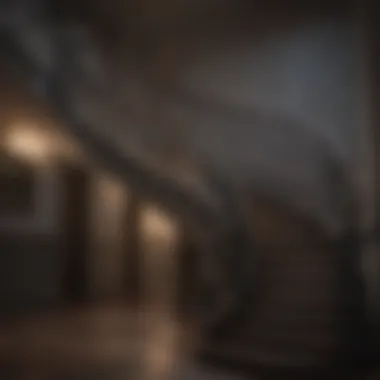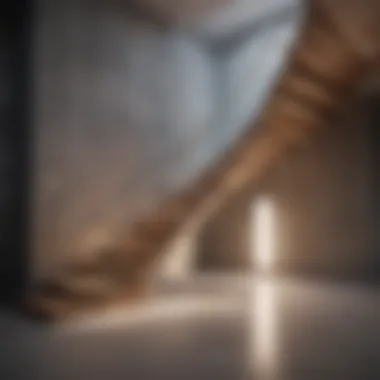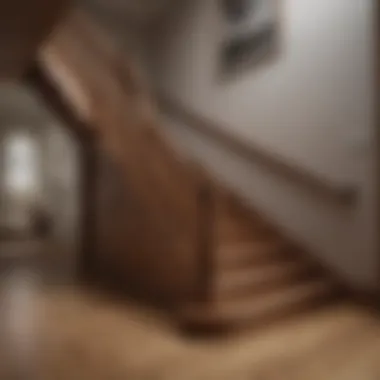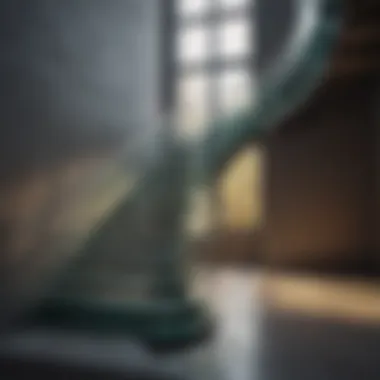Exploring Elegant Types of Stair Designs for Luxury Spaces


Intro
The construction of luxurious spaces often includes the subtleties of stair design, which serves more than utilitarian purposes. As we expand into outdoor decor ideas associated with stair types, understanding how scales shift from indoor to outdoor installations offers rich perspectives for high-end interior designers and event planners.
Outdoor Decor Ideas
Seasonal Inspirations
Stairs can serve as a focal point in garden designs and outdoor entertaining areas. In spring and summer, incorporating vibrant plants and floral elements can breathe life into external staircases. During the autumn, warm-toned foliage blends perfectly with wooden steps, while winter calls for a more subdued palette with pine or evergreen arrangements.
Integrating seasonal decor enhances not only the aesthetic appeal but also sets the mood for gatherings.
Furniture Selection
Choosing suitable furniture that complements outdoor stairs is essential. Elegant seating is often positioned near staircases for your guests' convenience. Opt for materials like wrought iron or teak, which can endure outdoor conditions while adding a touch of sophistication.
The selection of outdoor furniture can reflect the stair's materials — for example, pairing natural stone steps with rustic benches or robust dining sets can create cohesive visual harmony.
Decorative Lighting
Good lighting enhances safety and ambience. Wall sconces or pendant lights hung from overhead structures can brighten staircases effectively. Smart lighting solutions offer customization options that fit various moods and events, showcasing the beauty that stairs can offer even after sunset.
“Lighting is key; well-placed fixtures can showcase the best features of any stair design.”
Plant Arrangements
Using plant arrangements alongside or even within stair designs itself adds layers of texture and color. Vertical gardening techniques can be employed where steps are wide enough. Utilized judiciously, climbing vines or flowering shrubs can enhance both formal and informal settings.
Several stair models, like half-turn or spiral stairs, provide unique opportunities for plant integration, transforming these architectural features into garden highlights.
Hardscaping Solutions
The construction material of stairs significantly impacts surrounding landscaping. Pavers, stones, or tiles can replicate stair materials and create coherence in design. Integrating hardscaping solutions like ornamental rocks or boulders complements environmental themes.
Sustainable Practices
In an age prioritizing eco-friendliness, utilizing sustainable materials in stair designs can make both aesthetic and ethical statements. Recycled wood or composite materials not only weather the outdoor conditions well but also align with a luxury consumer’s value on sustainability.
Outdoor Entertaining
Outdoor stairs play a pivotal role in enhancing social spaces. They can facilitate smooth transitions between areas, encourage mingling, and expand your venue into the landscape itself.
Hosting Luxurious Gatherings
Thoughtfully designed stairs provide practical pathways to various areas of your outdoor venue, making them ideal for hosting events. Embellishing stairways with elegance, for instance, fluffy carpets or monochomatic decor elevates the atmosphere and encourages guest movement.
Party Planning Tips
Plan seating arrangements and dining setups around stairs to encourage flow. This design ensures that stair locations accommodate bar carts or comforts close to seating areas, facilitating gracious service.
Al Fresco Dining Trends
Combining sumptuous dining with nature's allure is a growing trend. Specially curated dining areas alongside exterior staircases increase access and provide enticing views, which elevates both setting and experience.
By recognizing the multifaceted roles that stair design plays, designers can craft spaces that aspire towards Dyson luxury. Little elements in these designs allow discerning individuals to indulge in the finest experiences that both function and flair should promise.
Preface to Stair Design
Stairs are an essential element of architecture, serving not just as a functional means to traverse different levels in a building, but also as a vital aspect of its aesthetic proposition. The introduction to stair design encompasses various dimensions of construction, from structural integrity to artistic expression. Understanding the multiplicity of stair types provides insight into how functionality and beauty intersect in the field of interior design.
The importance of stair design can be summarized in a few key elements. Firstly, it defines the flow of spaces within a residence or commercial setting. Well-designed stairs improve traffic patterns and ensure coziness in a space. Secondly, the design can enhance natural light through strategic placement of openings. Furthermore, unique styles can act as a focal point that complements or contrasts with surrounding interiors. This elevates the overall ambiance of the area, attracting attention without overwhelming the surroundings.
Importance of Stair Design
An effective stair design resonates with users on multiple levels. Selecting the right type of stairs is crucial for achieving a balance between luxury and practicality. Appropriate design ensures safety, accommodates a diverse range of users, and enhances convenience. A well-thought-out stair offers easier14 navigation between levels. Hence, integrating stair design into the broader architectural theme adds consistency and promotes accessibility.
Timeless designs often include practical aspects like width, flight depth, and rise, accommodating varied needs and preferences. As space constraints grow, thoughtfully designed stairs can maximize area usage while ensuring that the architectural framework is respected. Moreover, they meet typical safety regulations that govern their implementation, an important consideration for any responsible designer.
Historical Evolution of Stairs
The evolution of stairs is a testament to changing architectural tastes and technological advancements. Traditionally, stairs served utility purposes but over time, they began to assimilate beauty in their designs. Ancient civilizations, like the Greeks and Romans, employed grand staircases in public monuments to indicate power and elegance.
As we moved into the Renaissance, stair design emphasized decorative elements and intricate detailing. Later developments in the Industrial Revolution introduced metal and glass materials that enabled the creation of more avant-garde designs.


In the 20th century, with the advent of modern architecture, a shift occurred. Simplistic curves and lines characterized staircases, reflecting modern Möbel characteristics. Today, stair design not only considers historical context, but also addresses contemporary needs for sustainability and minimal aesthetics. This journey illustrates how stairs evolved from mere functional constructs to vital pieces of architectural art, influencing design narratives across history.
Types of Stairs
The subject of stair design is critical. It stands at the intersection of functionality and aesthetics. Each type of stairs serves a purpose, while also making a design statement in its environments. Knowing various designs helps in choosing what fits best in specific spaces. Different stair types cater to different architectural requirements, impacting how elegance is perceived.
Straight Stairs
Design Characteristics
Straight stairs feature one clear line of ascent. They are typically the simplest form of stairs. This design often includes simple treads and risers, with side railings for safety. Their linear form is appeal to many. The benefit of straight stairs is their efficient design that enhances circulation in open areas.
Advantages
Straight stairs are convenient and practical. They usually require less space and offer fewer construction complications. This simplicity attracts luxury designers aiming to create clean lines and understated elegance. However, they might not provide dramatic visual impact compared to more intricate layouts.
Typical Usage
These stairs find common usage in homes and commercial settings. They are often the first choice for minimalist designs. In clean environments, they effortlessly become a background feature. The simplicity lets other design elements shine without distraction.
L-Shaped Stairs
Design Characteristics
L-shaped stairs include a turn at the landing. This distinct shape moves away from a simple straight ascent. The design characteristics allow effective utilization of corner spaces, improving overall flow. Additionally, this configuration changes the visual interaction within a room, providing a thoughtful focal point.
Advantages
One of the key strengths of L-shaped stairs is their stability. They provide a good mix of style and functionality. The turn can create landing spots perfect for decor or functionality. This space organization adds charm, but it might require more layout planning to maintain an elegant atmosphere.
Typical Usage
Luxury residential spaces often utilize L-shaped stairs to enhance entryways and hallways. These stairs can also serve commercial spaces managing traffic effectively. Their versatility ensures wide applicability, marrying function and aesthetic.
U-Shaped Stairs
Design Characteristics
U-shaped stairs comprise a double turn making them visually interesting. This design allows creative use of space while providing an appealing aesthetic. The essence of U-shape supports open areas, integrating movement with decor charm. Such characteristics make it a strong choice for areas where presence needs to be felt.
Advantages
U-shaped stairs create two landings. This structure offers versatility in decorative opportunities. It introduces a combination of movement and space management, yet their installation can be complex. Navigating angles requires precise planning for both safety and style.
Typical Usage
U-shaped stairs serve grand entryways in luxury homes and estates. They might also find their place in boutique hotels aiming for memorable experience through unique spaces. This elegance of movement enhances guest interactions while remaining visually striking.
Spiral Stairs
Design Characteristics
Spiral stairs twist around a central point. This design efficiently uses floor space while producing stunning visuals. Their compactness allows for unique implementations in various architectural scenarios. A signature feature is the necessary central column that supports the steps and the design hightlight.
Advantages
Its aesthetic intrigue offers a distinctive style appeal. Spiral stairs often become focal pieces in smaller areas. However, they can be limiting for individuals with mobility challenges, making careful consideration necessary for functional settings.
Typical Usage
Common in both residential and commercial settings, spiral stairs enhance areas lacking wide space. They may serve as access points in deep buildings such as libraries or lofts, directing attention unknowingly toward them.
Floating Stairs
Design Characteristics
Floating stairs seem to hover in the air. They derive their unique nature from clever structural design. Often supported by hidden structures, they manifest minimalism in a striking way. Choose materials wisely, as they play an important role in the floating appearance.
Advantages
The visual appeal of floating stairs lies in their sleek modernism. It can make a space appear larger, lifting the atmosphere without占 oppressing it. This trust in design allows for varied materials but requires close attention on safety protocols.
Typical Usage


Floataing stairs find their place in ultra-modern homes and contemporary public spaces. The sophistication draws attention, but meticulous planning is needed to ensure safely secured structures.
Winder Stairs
Design Characteristics
Winder stairs sweep around corners without the need for landing. This unique twist offers a fluid pass between spaces. They can adapt well to tricky layouts where space optimization is key for navigational flow.
Advantages
Their ability to manage tight spaces is maximally advantageous. Winder stairs both look artistic and effectively connect different levels. However, the use of this design can limit furniture placements in adjacent areas due to space consumption.
Typical Usage
In high-end designs, winder stairs focus on maximizing elegance in shaded pass through rooms. They can place consideration to ornate decoration styles providing cohesion throughout related spaces.
Materials Used in Stair Design
The material choice in stair design plays a crucial role not only in the appearance but also in the performance and longevity of the stairs. Selecting the correct materials has implications for aesthetics, weight capacity, safety, and overall architectural harmony. From traditional wood to modern glass innovations, each material provides a distinct character and functionality that can enhance luxury spaces.
Wood
Aesthetic Qualities
Wood is often celebrated for its inherent beauty. It offers a warm and classic feel. The varied grains and natural hues allow for customization. This variety ensures that each staircase becomes a unique piece inside a luxury home. Preferences around this material typically incliude laying preferences such as edge grain or quarter-sawn finishes that can add depth to the design.
Durability
When it comes to endurance, wood presents a mixed picture. On one hand, hardwood types, like oak and maple, provide substantial strength and longevity. On the other hand, softer woods may not resist wear as well as desired. Tempered woods undergo treatments that improve durability, essential for high-traffic areas.
Maintenance
Maintenance is an essential point as well. Woods often require regular treatments to guard against moisture and scratches. While they can be home maintained with new finishes, periodic professional care may extend the lifespan dramatically. Skipping maintenance could lead to noticeable flaws compromising an elegant finish.
Metal
Aesthetic Qualities
Metal stairs present a futuristic look that appeals to modern sensibilities. There are numerous metals to choose from, including stainless steel, aluminum, and wrought iron. They can be constructed with sleek profiles and can inject a minimalist vibe. Their strong lines add visual interest and elegance to sophisticated interiors.
Durability
Metal is inherently robust. It resists the same types of damage encountered by wood or glass. This characteristic makes it ideal for space that sees heavy foot traffic, ensuring structural integrity remains high. The lifespan is often extended through finishes that withstand corrosion despite environmental challenges.
Maintenance
The required maintenance for metal design is notably minimal. A simple cleaning routine typically suffices to keep the metallic luster palpable. However, precautions must be taken to prevent rust on metals exposed to dampness.
Glass
Aesthetic Qualities
Glass gains attention through transparency and light play. It creates the illusion of more space while enabling light flow throughout the area. Modern design principles cherish elements that enhance visual openness. Glass may integrate well with metal or wood or can stand alone for dramatic flooring features.
Durability
Although tempered glass offers reasonable durability, it can be more fragile than wood or metal. It might crack under extreme force or impacts but still tends to hold up when constraints surround the stress factors. The use of laminated or reinforced glass can mitigate some risks while maintaining high aesthetic appeal.
Maintenance
Glass maintenance revolves around keeping it clean and clear of residues. A gentle cleanser can suffice, but stains might require more scrubbing. Properly cared glass stairs can keep areas looking polished without significant effort spent.
Concrete
Aesthetic Qualities
Concrete stairs project an industrial and modern aesthetic appealing in loft-style homes. They can be poured into various shapes and textures, offering plenty of versatility. Color and finish treatments let owners customize concrete stairs to add personal style while shy away from stark looks.
Durability
Concrete is one of the most durable materials. It withstands heavy loads, environmental factors, and tends to resist weathering. Its robust nature ensures that well-constructed concrete stairs often require minimal replacements.
Maintenance


Care of concrete varies depending on surface finishing. Smooth finishes could require sealing and short readjusts to keep optimal. Simple waxing preserves ease against slips and keeps aesthetic points afloat, yet regular checks ensure earlier damp repairs if needed.
Design Considerations
In any project involving stair design, certain elements must be meticulously considered. These considerations fundamentally influence both the functionality and the visual impact of stairs in luxury environments. Hence, addressing the prominent aspects of design considerations, is vital to achieve an elegant and practical outcome.
Safety Regulations
Safety is elemetary in all constructions, and stair design is no exception. Adhering to local and national regulations ensures that staircase designs not only comply with legal boundaries but also provide a secure environment for users. Here are important aspects within this context:
- Height and Rise: The total rise of stairs should be calculated carefully. Generally, a rise between 4 to 7 inches per step helps prevent falls.
- Tread Depth: Equal focus must be given to tread depth. A depth of at least 11 inches is typically recommended to allow sufficient foot placement.
- Handrails: Installing sturdy handrails enhances user experience. Regulations often dictate that handrails must be present on both sides of stairways and at certain heights to provide support.
- Non-Slip Surfaces: Adoption of non-slip materials reduces risks of falls, particularly in places where water or dirt may accumulate.
Ensuring these regulations are met is crucial not just for legality, but also for establishing a trustworthy and appealing aesthetic.
Space Constraints
Space often works as a limiting factor for stair design. Efficient utilization of available space is necessary while aiming for both functionality and elegance. Here are some considerations regarding space:
- Width Evaluation: Evaluate width carefully. A dimension of between 36-42 inches is typically found suitable for comfortable movement of individuals, but cramped settings might necessitate adjustments.
- Height Consideration: The height of the stairwell must allow for ample headroom, at least 80 inches for most people. Overly low ceilings create uncomfortable ascent and decline.
- Layout Implication: Multi-level residences let's use L-shaped or U-shaped designs, making them space-efficient within defined areas while allowing a visual splendor.
Assessing and prioritizing space constraints while you design enhances both form and function in stair implementation.
Aesthetic Integration
A staircase is more than just a functional construct; it is a statement piece within a home or building. Aesthetic integration of stairs into broader design elements is vital. Below are points to consider:
- Material Harmony: The chosen materials must complement the surrounding environment. Using luxurious woods like maple or walnut expresses sophistication, while metals may evoke modernity.
- Color Schemes: Employ color schemes that blend seamlessly with the broader setting whilst creating a harmonious visual flow.
- Lighting Enhancement: Strategic lighting elucidates the staircase, enabling it to serve as a focal point. Dramatic lighting can alter perceptions, inviting admiration without overwhelming.
- Architectural Context: Understanding architectural features such as style or local influences can greatly enrich the stair's contribution to the overall aesthetic appeal.
Effective aesthetic integration is crucial for ensuring that stairs elevate rather than detract from the spaces they inhabit.
By considering safety regulations, space, and aesthetics, one can devise stair designs that fully align with both practical requirements and high-end principles. This nuanced perspective play an integral role in addressing the aspirations of luxury clientele, thus ensuring aesthetic harmony and elevated functionality.
Trends in Stair Design
As the aesthetics and functionalities of spaces evolve, so do the designs of stairs. This section highlights pivotal trends that are currently shaping the realm of stair design. Understanding these trends is crucial for luxury spaces looking to enhance not only their functionality but also the overall ambience of the environment. Each trend provides unique benefits and visual elements, contributing to a modern, sophisticated aesthetic.
Minimalist Aesthetics
Minimalism in stair design emphasizes simplicity. Clean lines and unobtrusive materials define this style. With less clutter, the design allows other architectural elements or decor to shine.
- Functionality: Minimalist stairs tend to integrate well into various types of luxury designs, retaining both elegance and practicality.
- Materials: Commonly used materials include glass and metal. These materials enhance transparency and lightness, giving the impression of expansion rather than constraint.
- Design Work: It often involves open risers or floating designs that promote airflow and space, making areas feel more fluid and connected. This not only elevates aesthetic appeal but boosts safety as users can easily see the spaces around them.
Curvilinear Shapes
Curvilinear shapes add a stunning highlight to stair design by fostering organic movements. These designs are characterized by soft, flowing lines as opposed to the rigidity of angular frameworks.
- Impact: Curved stairs serve as a mosaic for the environment, leading the eyes fluidly along its path. This provides not just function, but also visual enjoyment that can sink deeply into the viewer’s memory.
- Space Usage: Often, these stairs fit beautifully in open concept spaces, utilizing corner areas better than standard staircases.
- Materials and Integration: A mixture of wood and stainless steel complements curvilinear shapes well, providing a harmonious feel with natural elements in the surrounding interior.
Sustainable Materials
With growing awareness regarding environmental sensitivity, sustainable stair design reflects modern responsibility. Use of eco-friendly or recycled materials has gained traction.
- Material Advantages: Bamboo, reclaimed wood, and recycled metal are becoming preferred choices because of their low environmental impact. This can add a narrative of sustainability to the build.
- Functional Design: Beyond aesthetics, these materials often offer durability, further extending the lifespan of the stair system built within a luxury space.
- Conscious Living: Integrating green materials resonates with consumers who value ethical consumption, creating personal connections between inhabitants and their spaces.
In summary, these trends reflect a shift towards sensible, aesthetic designs that underscore environmentally mindful practices for luxury spaces. Understanding these designs can greatly enhance the value and appeal of interior projects.
Embracing each of these trends allows designers to create stairs that not only serve their purpose but do so with grace and style. Organizing spaces to have fluidity, openness and environmental consciousness stand as a testament to the beauty and functionality that modern interiors aspire for.
Considering these elements will ultimately drive the elegance and noteworthy functionality of stair design.
Ending
Stair design is a critical element in architecture and interior planning. It offers more than just a functional component; a well-designed staircase can significantly enhance the overall aesthetic of a space and demonstrate sophistication in design choices. By understanding various stair designs and their implications, professionals can make informed decisions that reflect the needs of their clients while maintaining style and safety standards.
Summarizing Key Points
Throughout this article, various stair types have been detailed to show their unique properties. Key takeaways include:
- Diversity: Different stair designs, from straight stairs to spiral stairs, meet specific needs in varied architectural contexts.
- Functionality: The right type of stair can optimize space usage, facilitate movement, and comply with safety regulations.
- Aesthetic Contribution: Each stair type serves to enhance visual depth and intrigue within a given environment, impacting how spaces are experienced.
These considerations highlight the intersection of utility and elegance in stair design. It is vital to analyze the specific requirements before selecting a staircase for any luxurious setting.
Future of Stair Design
As preferences in architecture and interior design evolve, stair design will also experience innovative transformations. Anticipated trends include:
- Integration of Technology: Smart stairs with changing light systems or integrated sound systems to create personalized environments.
- Sustainability Practices: Increased use of recycled materials and eco-friendly solutions reflecting a global push toward environmental responsibility.
- Personalization Options: Greater demand for unique and customized designs that reflect individual tastes and lifestyle needs.
A forward-thinking approach to stair design considers these modern influences while maintaining a strong grasp on traditional functional and aesthetic principles.







